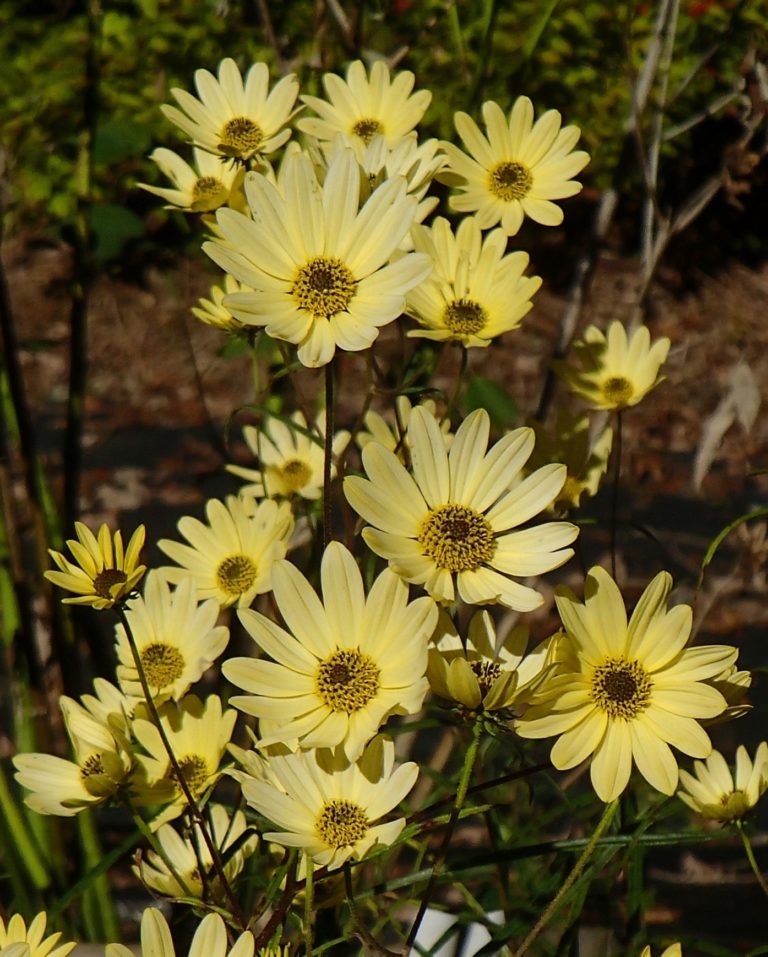Swamp Sunflower is a clump-forming, upright, late-blooming perennial sunflower — the latest flowering of the sunflowers (October and even November). It is found in bottomlands, swamps, and other natural wet habitats as well as in disturbed wet areas, on roadsides and in ditches. It thrives in full sun in moist soils — but it can also withstand drought. In the garden, Swamp Sunflower is handsome, growing to a lofty 6 to 8 feet with attractive, roughly textured, threadlike foliage. The species, native to central and eastern U.S., is found in piedmont and coastal counties of NC. Although the flowers are not huge like some Helianthus sunflowers, there are a great many of them, and they attract a whole range of lively pollinators and then birds to consume the seeds. The flowers of the cultivar ‘Mellow Yellow’ are slightly smaller and of an unusual, softer and gentler yellow than the species, a different slant on fall color in the garden. Being such a late bloomer, the hue of ‘Mellow Yellow’ plays against the blues and purples of Climbing Aster, (Ampelaster caroliniana) and the Aromatic asters (Symphyotrichum oblongifolium), as well as the flaming fall foliage of woody shrubs such as Serviceberry (Amelanchier canadensis) and the pink of Muhlenbergia. Gorgeous!
NURSERY HOURS
Wednesday: 10-4 Thursday: 10-6 Friday-Saturday: 10-4 Sunday: 12-4
Helianthus ‘Mellow Yellow’

Key Info
Scientific Name: Helianthus angustifolius L. 'Mellow Yellow'
Common Names: Swamp Sunflower, Narrowleaf Sunflower, Mountain Daisy
Family Names: Asteraceae (Composite, or Daisy Family)
Plant Type: Herbaceous perennial
Flower Color: Yellow
Special Characteristics: Tolerates some salt, Tolerates some drought, Attracts butterflies, Attracts birds, Tolerates wet conditions, Tolerates Black Walnut, Rhizomatous, Good for cut flowers
Additional Info
Habit: Upright herbaceous perennial with sturdy, purplish, pubescent stems terminating in many 2-3” flowerheads; basal rosette is present.
Height: 6'-10'
Spread: 4'-5'
Soil Conditions: Moist to wet, acidic soils, sandy loam, clay loam, clay.
Leaves: The alternate leaves are lance-shaped or linear, simple, pubescent, with pointy tips, about 6" long x 1/2" wide and sessile. The smooth margins are usually revolute or rolled under. In the axils of the leaves there are often clusters of untoothed, stalkless smaller leaves.
Flowers (or reproductive structures: Helianthus angustifolius has radially symmetric flowerheads 2-3 inches across, with dark brown/purple globe-shaped cones of disc florets surrounded by 10 to 20 golden yellow ray florets. The ray florets of 'Mellow Yellow' are a little shorter and of a distinctly softer color than those of the species..
Fruit: Golden brown seed clusters follow in late fall and remain into winter to feed the a great many birds.
Natural Distribution: Flood plains, bottomlands, swamps, bogs, wet meadows, savannas, roadsides, ditches and disturbed wet areas.
USDA Hardiness Zone: 6 to 9
USDA Wetland Indicator Status in NC: FACW
Pollination: Bees, butterflies, other insects
Wildlife Connections: The nectar and pollen attract native bees, honeybees, butterflies, wasps, beetles and pollinating flies. Green tissues host caterpillars of Gorgone Checkerspot, Silvery Checkerspot, Bordered Patch and Painted Lady butterflies. Seeds are relished by American goldfinch and many other songbirds. The plant is unpalatable to deer and other herbivores.
Propagation: By division.
